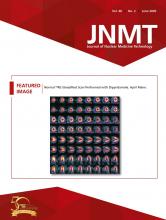RATIONALE
Electrocardiographic gating enhances the diagnostic and prognostic capability of myocardial perfusion imaging and provides incremental information over perfusion data alone in patients with known or suspected coronary artery disease. Gated myocardial perfusion imaging allows assessment and quantification of the global and regional function of the left ventricle. Quantitation of ventricular function includes end-diastolic volume (EDV), end-systolic volume (ESV), systolic volume (EDV – ESV), ejection fraction ([EDV – ESV]/EDV × 100%), wall motion, wall thickening, diastolic function, phase analysis, peak filling rate, and time that peak ejection rate occurs.
INDICATIONS
Gated myocardial perfusion imaging is indicated for detection of coronary artery disease in patients with an intermediate pretest probability or high coronary risk factors, for risk stratification after myocardial infarction, and for evaluation of the efficacy of drug therapy or revascularization. The indication for the myocardial perfusion imaging study should meet the appropriate use criteria for cardiac radionuclide imaging. If the patient history does not meet these criteria, the interpreting or ordering physician should be contacted for verification (5).
CONTRAINDICATIONS
Contraindications include pregnancy, breast-feeding, or a recent nuclear medicine study (radiopharmaceutical-dependent). Pregnancy must be excluded in accordance with the local institutional policy. If the patient is breast-feeding, radiation safety instructions should be provided.
PATIENT PREPARATION
Instruct patients to wear comfortable clothing; to fast for 4 h before the test; to refrain from taking any caffeine, decaffeinated products, or nicotine for at least 12 h before the test (in the event the patient cannot perform an adequate stress test and is switched to a pharmacologic stress test); and to bring a list of all their medications. Caffeine-containing items include coffee, tea, cola, hot cocoa, Excedrin (GlaxoSmithKline), Sunkist orange soda (Cadbury Schweppes), energy drinks, decaffeinated coffee, herbal tea, decaffeinated soda, chocolate, No-Doz (Lil’ Drug Store Products, Inc.), and Anacin (Prestige Consumer Healthcare Inc.). With the agreement of the patient’s physician, β-blockers, calcium channel blockers, and nitrates should discontinued for 48 h before the test, and nitroglycerine should be discontinued for 4–6 h. Aminophylline, theophylline, Aggrenox (Boehringer Ingelheim), Persantine (Boehringer Ingelheim), and dipyridamole should be discontinued for 48 h before a pharmacologic stress test. Other medications may be withheld or given at the discretion of the ordering physician. Instruct diabetic patients to refrain from taking oral diabetic medication or insulin the morning of the test and to take half the usual dose of insulin the evening before the test.
ACQUISITION
Before the acquisition, obtain a focused history that includes the indication for the test, medications, symptoms, cardiac risk factors, history of past and current diseases, and history of interventional or surgical procedures. Table 1 summarizes the radiopharmaceutical identity, dose, and route of administration, and Table 2 summarizes the acquisition parameters. Because myocardial perfusion imaging is a comparative study, try to acquire rest and stress SPECT studies in same fashion (e.g., same patient position and radius).
Inject patient with 201Tl or the low dose of either 99mTc-tetrofosmin or 99mTc-sestamibi at rest.
Acquire SPECT rest study at 30 min (for 99mTc-tetrofosmin), at 45 min (for 99mTc-sestamibi), or at 20 min (for 201Tl) after injection.
Place 3 electrocardiography electrodes on patient’s chest, and attach electrocardiography wires (white on right upper chest, black on left upper chest, and red on left lower abdomen). In patients with peaked T waves, move electrodes to prevent double counting. Usually, moving red electrode toward patient’s back will solve this issue.
Place patient supine with either left arm or both arms over head and out of field of view. If patient cannot raise arms, arms-down imaging can be performed.
On 90°-configured dual-head camera, use starting gantry position of 0° (head 1 at 45° right anterior oblique, head 2 at 45° left anterior oblique). On single-head camera, use starting angle of 45° right anterior oblique.
Place heart as close as possible to center of field of view. Position camera heads as close as possible to patient and table to obtain 180° acquisition.
Make patients as comfortable as possible, explain to them the importance of holding still, and tell them how long the acquisition will take.
To avoid artifacts, make sure counts in heart appear as hot as those in liver. There should be no bowel activity interfering with visualization of heart. Imaging should be delayed to allow for adequate liver and bowel clearance, if necessary.
Review raw data as a cine projection before moving patient to evaluate quality of acquisition, noting potential artifacts such as poor counts, dropped frames, patient motion, or attenuation. Repeat imaging in the event of significant artifacts.
Inject patient with high-dose 99mTc-tetrofosmin or 99mTc-sestamibi at peak exercise or peak coronary vasodilatation.
Acquire SPECT stress study with electrocardiography gating after patient adequately recovers from exercise (minimum, 15 min). After injection of pharmacologic stress, wait 30–45 min to begin imaging.
Review raw data as a cine projection before moving patient to evaluate quality of acquisition, noting potential artifacts such as poor counts, dropped frames, patient motion, or attenuation. Repeat imaging in the event of significant artifacts.
Radiopharmaceutical Identity, Dose, and Route of Administration
SPECT Acquisition Parameters
PROCESSING
Process SPECT images per manufacturer’s recommendation and interpreting physician’s preference, including preprocessing, attenuation correction, motion correction, reconstruction, and filter selection (filtered backprojection or iterative).
Reconstruct images into short-axis, vertical long-axis, and horizontal long-axis views.
Align perfusion and viability slices so that slices match same sections of myocardium. Display short-axis slices from apex to base. For vertical long-axis slices, point apex toward left of image. For horizontal long-axis slices, point apex up.
Normalize images to hottest pixel in each slice.
Display normalized slices and other quantification images such as polar plot, left ventricular volume curve, and summed stress–rest scores.
REFERENCES
- 1.
- 2.
- 3.
- 4.
- 5.
- 6.







